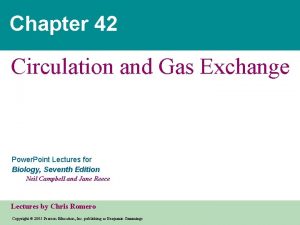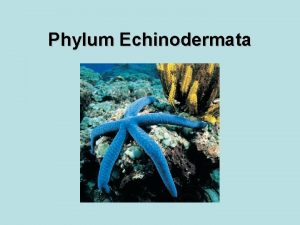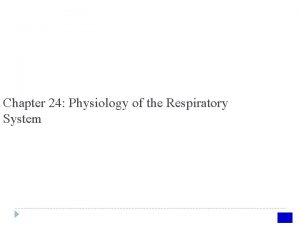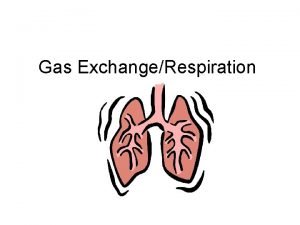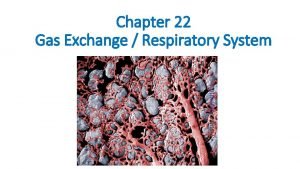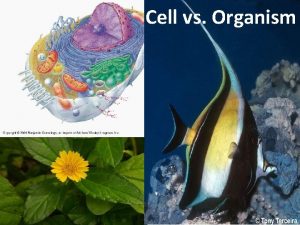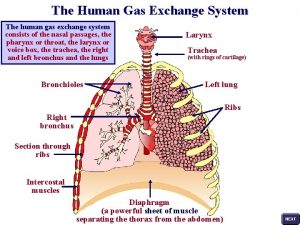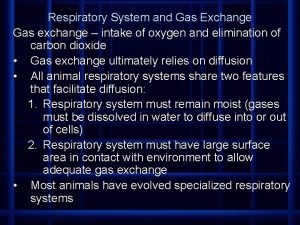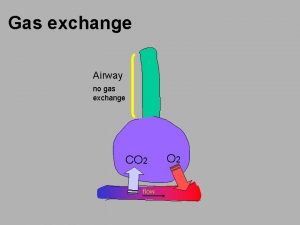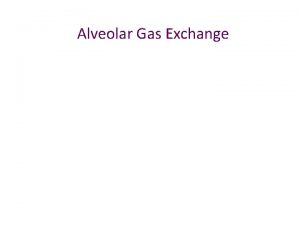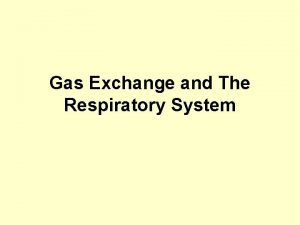CHAPTER 9 GAS EXCHANGE GAS EXCHANGE Human gas














- Slides: 14

CHAPTER 9: GAS EXCHANGE

GAS EXCHANGE • Human gas exchange system links circulatory system w/ atmosphere • Clean and warm entering air • Maximize surface area for diffusion of oxygen and carbon dioxide • Minimize distance for diffusion • Maintain adequate gradients for diffusion

GAS EXCHANGE • Need oxygen for respiration • Multicellular organisms have gas exchange surface where external oxygen can diffuse into body, and carbon dioxide can diffuse out • In humans: alveoli (found in lungs, total surface area over 70 m sq)

LUNGS • Found in thoracic (chest) cavity surrounded by pleural membranes, which enclose an airtight pleural space (aka pleural cavity) • pleural space contains small amount of fluid to reduce friction during ventilation

TRACHEA, BRONCHIOLES • Leading from the throat to the lungs is the trachea, and at the base are two bronchi (singular: bronchus) which then subdivide several times into even smaller bronchioles

TRACHEA, BRONCHIOLES • Cartilage in the trachea and bronchi keep airways open and air resistance low, and prevents them from collapsing or bursting as air pressure changes during breathing • Trachea: regular C-shaped cartilage rings • Bronchi: irregular blocks of cartilage

BRONCHIOLES • Surrounded by smooth muscle which contract/relax to adjust diameter of airways • Relax= greater diameter, more air • Possible b/c no cartilage

WARMING AND CLEANING THE AIR • As air flows through nose and trachea, it is warmed and moistened by evaporation from the lining to protect lungs from drying out (desiccation) • Small hairs inside nose and mucosal membranes trap suspended particles (dust, pollen, bacteria, viruses)

MUCUS • In trachea and bronchi, goblet cells of the ciliated epithelium produce mucus, a slimy solution of mucin, which is composed of glycoproteins with many carbohydrate chains that make them sticky

MUCUS • Also made by mucous glands beneath the epithelium • Some chemical pollutants, like sulfur dioxide and nitrogen dioxide, can dissolve into mucus and irritate the airways

MUCUS • Beneath goblet cells are ciliated cells that carry mucus upwards towards the larynx, where it is (usually) swallowed so pathogens can be destroyed by the acid in our stomachs

MACROPHAGES • Phagocytic white blood cells patrol the surfaces of the airways scavenging small particles like bacteria and fine dust

ALVEOLI • Terminal end of bronchioles. Have very thin lining of epithelial tissues (single cell thick) and are surrounded by capillaries carrying deoxygenated blood • Thinness of barriers ensures fast diffusion • Walls contains elastic fibers which can stretch and recoil during breathing

ALVEOLI • Oxygen moves into bloods via partial pressure differences between alveoli (high) and capillaries (low) • Carbon dioxide moves from high in capillaries to low in alveoli • Blood is constantly moving so pressure gradient is maintained
 Gas exchange key events in gas exchange
Gas exchange key events in gas exchange Chapter 42 circulation and gas exchange
Chapter 42 circulation and gas exchange Chapter 8 human needs and human development
Chapter 8 human needs and human development Chapter 8 human needs and human development
Chapter 8 human needs and human development Determination of exchange rate
Determination of exchange rate Voluntary exchange activity the pearl exchange
Voluntary exchange activity the pearl exchange The actual exchange of gases occurs at the site of the
The actual exchange of gases occurs at the site of the Echinodermata
Echinodermata Bioflix activity: gas exchange -- inhaling and exhaling
Bioflix activity: gas exchange -- inhaling and exhaling Countercurrent exchange in fish
Countercurrent exchange in fish Echinoderms have endoskeleton
Echinoderms have endoskeleton Pulmonary gas exchange and transport diagram
Pulmonary gas exchange and transport diagram Grasshopper respiratory system
Grasshopper respiratory system Adaptations of xerophytes
Adaptations of xerophytes Alveoli gas exchange animation
Alveoli gas exchange animation

